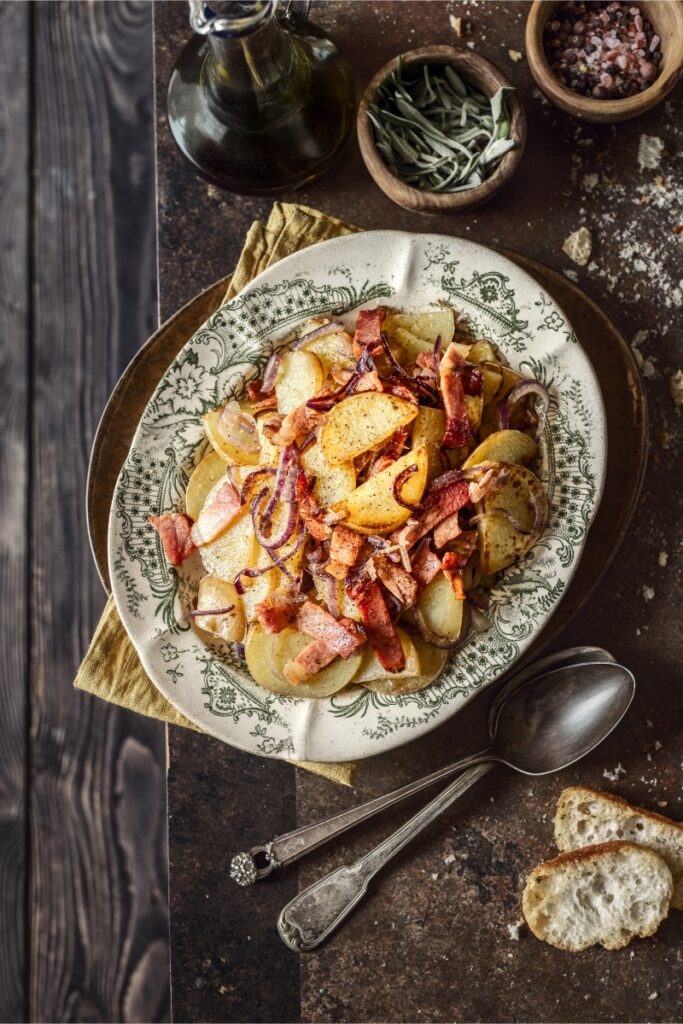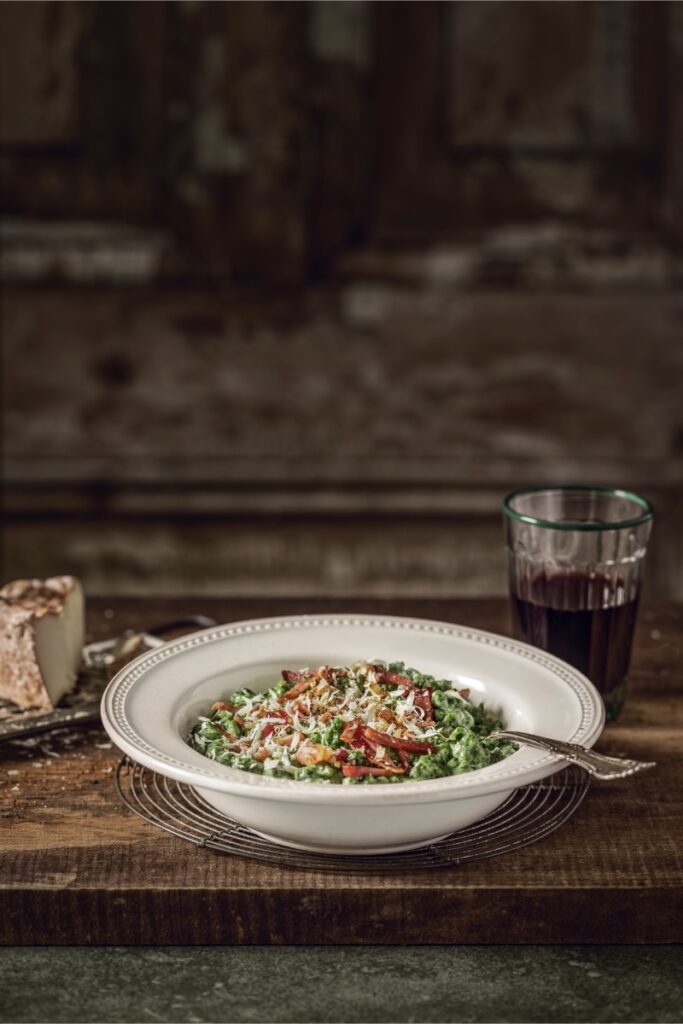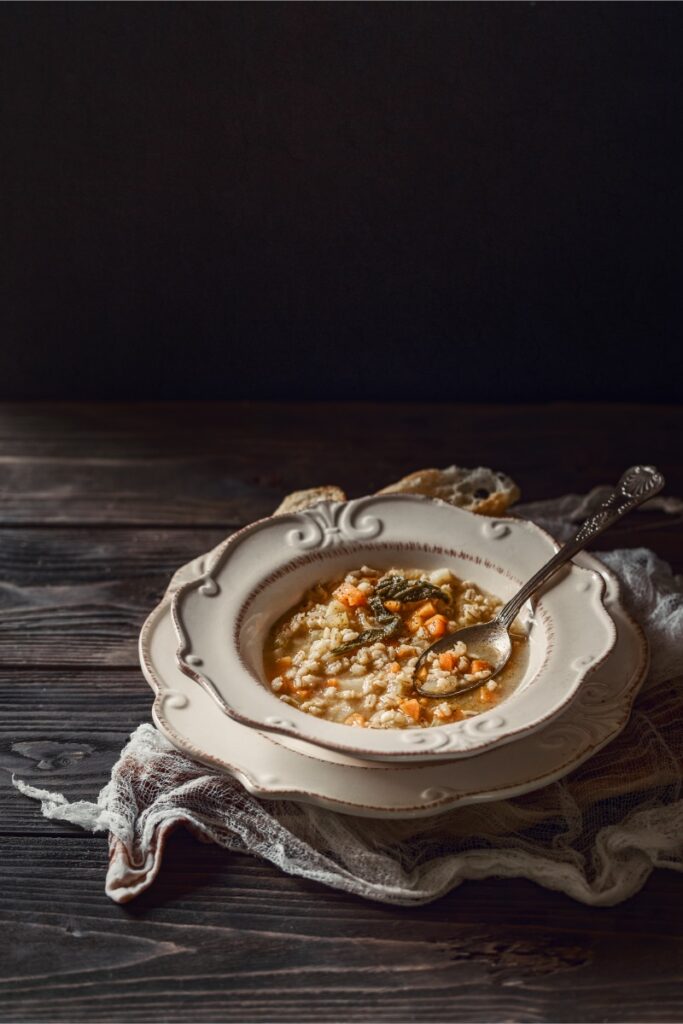TABLE’s Italian correspondent Sara Ghedina was born in Cortina d’Ampezzo, the site (with Milan) of the 2026 Winter Olympics. By sharing some of the region’s most loved recipes, Sara invites us to immerse ourselves in the games and the culture of their host country. Prepare your feast for the opening ceremonies on February 6.
Cortina Recipes for the 2026 Winter Olympics
Casunziei Rossi (Red Beet Ravioli)

Crescent-shaped red beet ravioli are, hands down, the most famous dish from Cortina d’Ampezzo. They are part of this resort town’s attractions, along with the beautiful mountains and challenging ski slopes. Every mountain hut, hotel, or restaurant offers its own version, and of course, every family has their own recipe. The uniqueness of the ravioli lies mainly in the earthy and colorful filling. The pasta shell should be extra thin to allow for the flavor (and the color) of the beets to shine through.
I grew up eating homemade casunziei prepared with love by both my grandmothers. As kids we would argue which of the two versions was our favorite. My brother and my cousin were often competing against each other to see who was able to eat the most, with my brother usually winning. It wasn’t difficult, really, because doused in butter, poppy seeds, and freshly grated Parmigiano, they are that good!
Ampezzo-Style Potatoes

Cortina d’Ampezzo has always been a borderland. It is in the province of Belluno in the Veneto region, and was part of the Austro-Hungarian Empire for more than a century until Italy annexed Cortina in 1918, at the end of World War I. From Veneto, Cortina has certainly inherited polenta, which some often serve with game meats, but local cuisine is generally from Austria and South Tyrol traditions. This is where speck comes in. It’s one of the most famous cured meats of the Tyrolean region and one of the Dolomites’ culinary specialties. Speck comes from boneless pork leg. It is both cured and smoked, which gives it a more intense flavor than its cousin, prosciutto.
Ampezzo-style potatoes are a warm and comforting side dish made with a few simple ingredients, but their flavor is so intense and unique that it immediately puts you in a “Dolomite mood.” Perfect for dinner after a day spent on the ski slopes, you can serve these potatoes as a main dish along with a green salad and a thick slice of local cheese. Quantities for this recipe are very approximate. My suggestion is to eyeball everything and use your instinct to add the ingredients in the amount your heart desires. If you can’t find speck, use smoked pancetta or bacon instead. The result will not have the same distinct flavor, but it will be equally satisfying.
Spinach Spätzle

Spätzle are a type of dumpling typical of South Tyrolean cuisine. Traditional spätzle uses flour, eggs, and water as a side dish for meat courses. In Cortina you will find a green version, with spinach added to the basic dough. They are served on their own as a main course, just like gnocchi, usually topped with cream sauce and strips of sautéed speck. It is a rich and tasty dish perfect for Sunday lunch, dinner with friends, or any time you want to indulge.
They’re very easy to make, but you will need a spätzle maker, a tool similar to a horizontal grater with large holes that will let irregular drops of batter fall directly into the boiling water (you can easily find it online or in kitchen supply stores). Spätzle cook in just a few minutes. When they float to the surface, they’re ready to be tossed in the pan with the sauce, which will stick perfectly to the little dumplings, thanks to their irregular shape. You can also try them with melted butter and Parmesan cheese or with a simple tomato sauce, a less traditional variant that is nevertheless delicious.
Kaiserschmarrn

Many of the desserts and pastries typically found in Cortina are of Austrian origin, such as Linzertorte, Sachertorte, Apple Strudel, or Krapfen. Kaiserschmarrn is no exception: in almost every mountain hut in Cortina you’ll find a local variation of the original Austrian treat, which was the favorite dessert of the Emperor (Kaiser in German) Franz Joseph, hence its name. A true energy boost after a day spent skiing or hiking, Kaiserschmarrn is not an omelet nor a crepe, but something in between. The simple batter made with egg, flour, and milk is enriched by chunks of apples and rum-soaked raisins, and the result is a giant, fluffy, and light pancake, which is then torn into bite-size pieces and served warm with lots of powdered sugar and cranberry preserve.
There are many ways to prepare Kaiserschmarrn. Omit the raisins or use water instead of rum to soak them for an alcohol-free version. Separate the eggs and beat the whites until stiff peaks form to have an even fluffier dessert. Substitute vanilla extract for lemon. Skip the apples if you prefer (although I do not recommend it). Whichever path you choose, this simple dish comes together in 15 minutes! Beyond dessert, it makes a great breakfast or brunch, and it is loved by adults and kids alike.
Barley Soup

Simple, warm, and comforting, this soup is ideal for an easy midweek dinner that will combine the convenience of everyday cooking with the nourishing goodness of your grandma’s’ recipes. Barley soup is a staple in South-Tyrolean cuisine and in the Dolomites, too. Its unique character comes once again from speck, which gives it a distinct smoky flavor. The traditional soup is made with whole barley grains, which need to be soaked overnight. However, most people now use pearled barley, which doesn’t need soaking and can be cooked immediately. If you want an even richer and creamier result, try adding 1 cup whole milk (or more) about 10 minutes before the soup is ready. This is how we used to make it at home, and it was pure heaven!
Story, Styling and Photography by Sara Ghedina
Subscribe to TABLE Magazine’s print edition.
